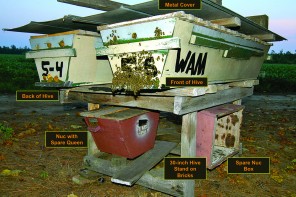by James E. Tew
The modern chaotic honey bee Internet
The answer is out there. Can you find it?
Well here it is – another monthly article beginning with another monthly justification about why it’s okay if I look backward a bit. In previous articles, I’ve asked this question before, “When am I an aged, experienced beekeeper and when am I simply boring and irrelevant?” It’s hard for me to tell.
The early beekeeping Internet was very limited but generally factual and correct. It was mostly academic or government agency text with very few photos and no video. Access to some of these resources required setting dipswitches on printers; inputting nonsensical keystrokes on our Tandy computers as we marveled at the clarity of our newest monochromatic screen and the huge amount of storage that was available on the new 5¼” formatted floppy disk. You did not drag and drop anything. That feature did not exist.
Interestingly, my early high-end Z80-based S-100 bus Cromenco computer looked much like the Apple IIe. (I got all that old technical information off the Internet. I have no idea what it all means.) This was the first machine with which I was able to perform early email transmissions.
My point? Our best computer equipment at that time is quaint now, but the information that was distributed by this simple, quaint equipment was free (no ads anywhere), generally accurate, and presented in a plain, uncluttered (boring?) manner. Man, those days are truly gone!

I couldn’t use a bee page so I chose another of my
interests – bluebirds. As you have seen, look at all the side and upper ads. I could not show the pop-up screen that came later. This is just a typical web page.
Now it seems that every beekeeper and all their brothers and sisters now have a presence on the Internet. For instance, load the search string, “types of honey bees” in the search field in days of yore and you probably got a pictureless article on the various races of honey bees with a written description of their characteristics. Now, type that string into the current search engine of your choice, and you will be bombarded with all types of queens for sale, the best queens available – buy them here! There will be ads and popups all over the page about everything and maybe even a little something about queens, cemetery searches, where to buy leaf vacuums, arrest warrant records, and often a side ad offering to show you pics of “entertainers’ clothing equipment failures – pics they don’t want you to see!”) Stay focused.
Somewhere in this pulsing, jumping, hot-key loaded, looped video virtual minefield of distraction, your answer may or may not be found. With so much to lure you off subject, it may not be easy to avoid The Siren Song of the Lorelei. Yet, in this increasingly chaotic morass is where we now get our virtual beekeeping information. More and more, it seems amazing that beginning beekeepers manage as well as they do when electronically searching for practical information that is new to them. It is difficult even for experienced beekeepers.
A test case . . .
A simple way to see the confusion and informational clutter present in even the simplest search, key in the string, “Is honey a harmful food.” I bet most of you will be surprised. I don’t want to select any specific web address. No doubt, I would get slammed so I ask that, from the list, you select the URL address of your choice. As I was pursuing the sites for this article, I did get lured away from the honey topic to a listing announcing ten toxic foods you probably have in your kitchen – right now! Yes, honey was one of them. The other nine were: any fruit with pits, rhubarb, nutmeg, potatoes, almonds, tomatoes, tuna, cassava, and cashews. I suppose that I just might have to give up rhubarb.
The Internet has given any one who wants it a soapbox for shouting their electronic opinions and concerns. Ironically, this is a good thing, but it puts great pressure on the searcher to select proper, correct, and timely information.
When searching for bee information, the suggestions that follow are just my way. I am well aware that my criteria will not satisfy all and will even annoy some of you. Everyone must decide whether or not a web site meets his or her expectations.
If a web site wants to sell me something – queens, hive equipment – anything, unless I am actually looking for something to buy, I go more slowly with their educational information. There is a chance of bias on these commercial sites. If the web site is shrill on any issue such as: GMOs, pesticides, pollinator losses, hive designs, I again explore just a bit more carefully. Sometimes, such sites have strong emotional agendas with which I may or may not agree. I generally expect educational facilities, medical facilities and state, and federal agencies to provide me with balanced bee information.
Obviously, all web sites presented in the list merit some review and caution. Even accepted facts can be presented in different ways with the results being different conclusions. An example would be American foulbrood control. Destroy and burn or shake onto clean equipment and feed antibiotics? In fact, both recommendations are academically correct, but you must decide which of these “right” recommendations aisbest for you.
Many of you already knew this – I had not fully realized it.
During past decades, the honey extractor market has dramatically changed. The last time I purchased an extractor was sometime in the late 1980s and even then it was for the Ohio State bee lab. At that time there were about four major manufacturers of honey processing equipment in the U.S. Happily, they are all still with us today, and no doubt also experienced changes. But now modern honey extractors are available all over the world. Whereas there once were 15-20 models across all manufacturers, today there are hundreds. Times have changed, but it’s mostly good changes.
This is not the first time that extractor production has been through evolutionary changes. In my earliest beekeeping years in south Alabama, I had a two-frame galvanized, hand-cranked, gear driven, extractor with a brass valve for draining honey. It had been abused, but my beekeeping family and I were able to bring it up to standards. The Standard Churn Company in Wapakoneta, Ohio, manufactured it. Isn’t life funny? I was using that antique extractor in Alabama, and now I live in Ohio hardly one hundred miles from where it was manufactured. Do I treasure that extractor now? Well, I would if I knew where it was. Thinking that we had been given the device and having made it a part of our small beekeeping operation for nearly 15 years, a family member of the original owner, contacted us and said, “They needed it back.” That was a surprise. We gave it back. I have no idea where it lives now.
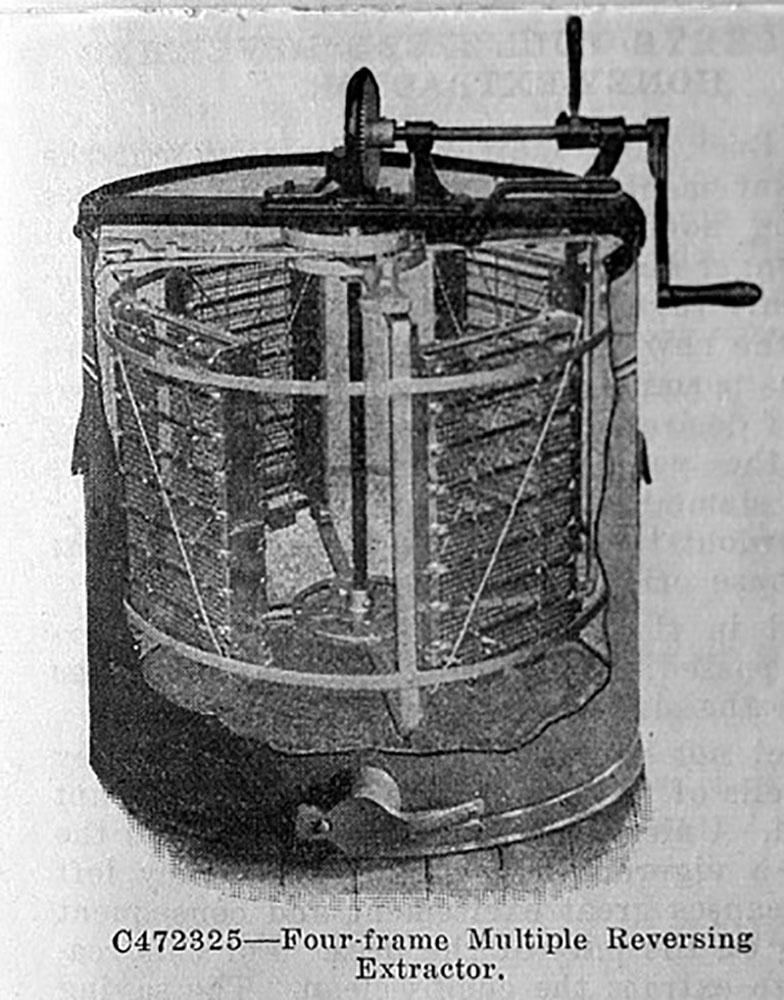
This is simply a four-frame extractor that was available in 1922. It was made from a combination of metals. The tank was galvanized with soldered seams. Of course, this is unacceptable today. It was gear driven. The gear drive could be disengaged and separate hand brake was available for stopping the spinning extractor basket. Amazingly, it was equipped with reversing baskets so frames did not need to be removed to extract opposite comb sides. Though it could be tied down. it was very nearly heavy enough just to use without tie downs.
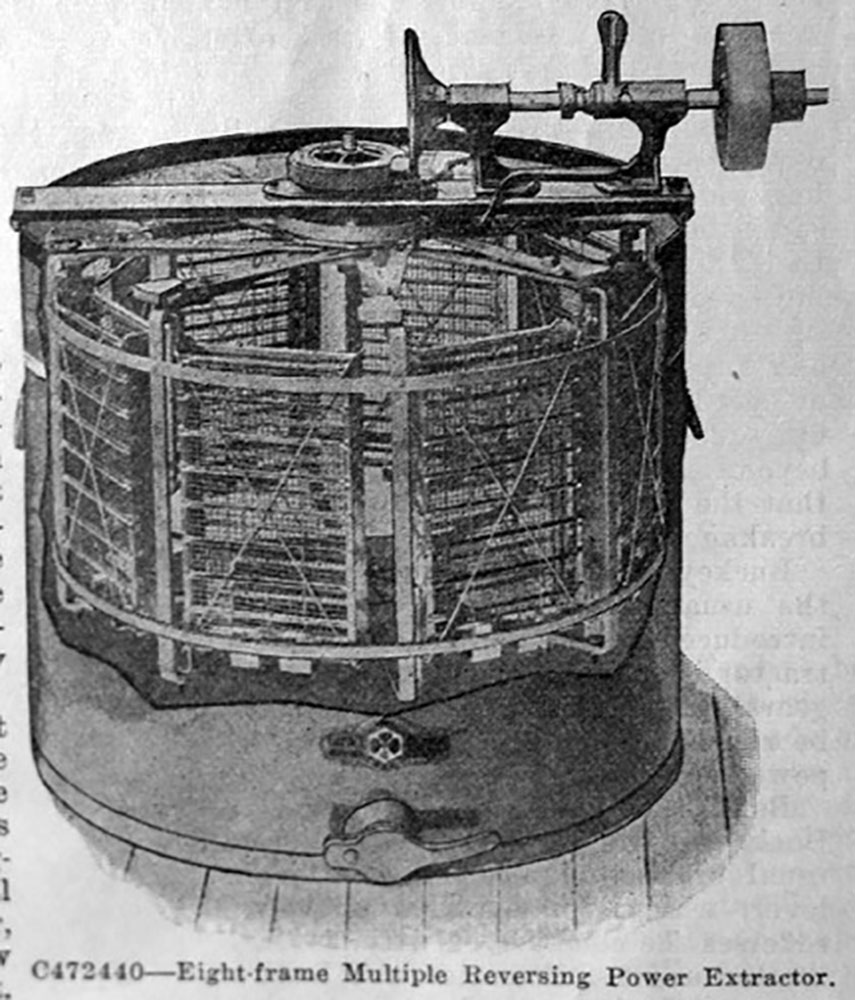
Apparently, all those years ago, companies such as the churn company branched into honey extractor production. It makes sense. Fruit juice presses, honey extractors, milk churns, sausage stuffers – these devices are all of a similar concept. I can only surmise that as the bee manufacturing industry advanced, the secondary companies increasingly were unable to compete. However, there was mention of a new Standard Churn Company extractor for sale in 1940.
In our earliest years of honey extraction, the big honey producers had not yet risen to the top. The equipment mega-beekeepers use today is just short of spectacular. From my antique collection of old bee supply catalogs, I selected the A.I. Root Company’s 1922 edition. During those years serious beekeepers with fairly small numbers of hives were “King of the Hill.” The few supply companies with metal shops produced equipment that cannot be found today. Today’s hobby equipment is efficiently manufactured from stainless steel and is reasonably simple. Either you crank them or they have an electric motor to drive the basket. Not the old equipment. Check out the two poor quality photos I have presented below. They are all I could get.
The second extractor shown in yet another poor photo is of an eight-frame unit. All of that operational equipment for only an eight-frame extractor.
A.I. Root was not the only company manufacturing these husky extracting machines, but the Root equipment is the one for which I have a catalog. This machine was flat belt driven most likely by hit/miss 1½ hp gasoline engine. There was no mention of gasoline fumes in the extracting room. Later and more conveniently, electric motors were used. Notice that on the cross shaft there are two differently sized flat pulleys. The larger was to run the extractor basket while the smaller of the pulleys was to run the honey pump. The basket could be disengaged allowing the cross shaft turned all the time. The belts were exposed and would be considered dangerous by today’s standards. I suspect they were dangerous by 1922 standards.
As it became time to reverse the baskets, the brake would be partially applied and the speed momentum would flip the baskets to the other side. Eight frames could be extracted without removing them. The honey pump ran constantly. The sheer heft of the full basket running on ball bearings, with the clutch released, would continue to extract as the basket slowed for refilling. It was said “the breeze given off by the spinning basket was refreshing.”
The down side – the unit cost $160. I would assume that freight was not included. In today’s dollar money, that would be $2171.67. The average annual salary of the typical American worker in 1922 was $3,143.46. Okay . . . I’m not sure where to go with this. These units were really expensive. Yet, through the years, thousands were sold. If you can find one today, it can, most likely, be made to run – there is the business about the galvanized tank and soldering.
I suspect that the typical beekeeper of 1922 purchased the Novice two-frame extractor that is much like ours today – but now made of stainless steel. The 1922 unit sold for $28, which would be $380 today. Bottom line – extractors have always been expensive. That should help explain all of the build your own plans that have always existed in print and on the Internet.
Is there good news for beekeepers today? Fundamentally, extractors have not changed since the earliest concept. Though lighter and simpler, even today’s smaller metal extractors seem to last forever. You may have to remodel, repair, or tie them down, but today’s extracting devices have similar life spans to the old classic units. Get one, treasure it, and put it in your will, and as soon as you can, put a motor on it.
For the Beginner – Will I get stung if I keep bees
Yes, bees will sometimes sting you. If bees did not occasionally sting, I suppose everyone would consider keeping bees. The fact is that in the wild, a lot of other animals would just love to get that great hoard of honey and all that high-quality protein in the brood nest. Obviously bees could never have succeeded as a species if they were not able to defend their food supply, and they have become pretty good at it.
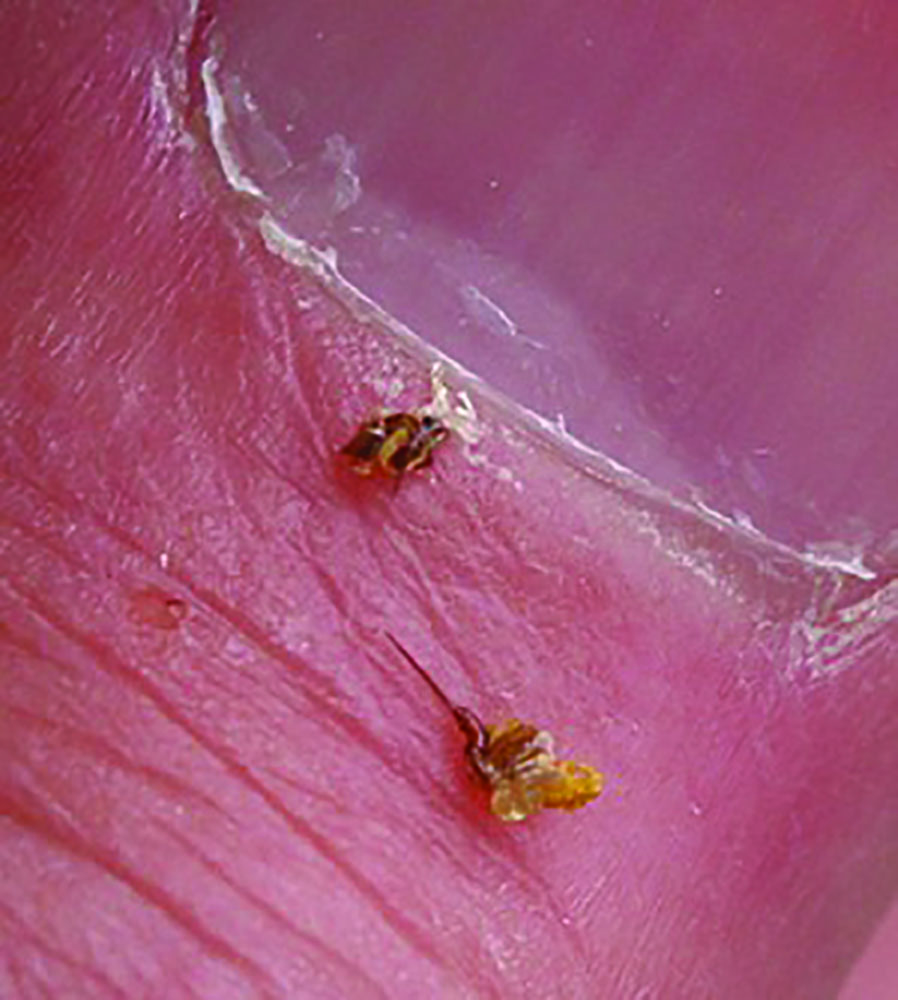
Bee stings that have been removed.
Beekeepers are prepared for this reaction. There is traditional protective gear available from bee supply companies that will prevent all stings if the beekeeper chooses to wear it (… but most will be a very hot outfit in the Summer). People who are not prepared with proper protective clothing and do not have a basic understanding of bee behavior can easily see defensive bees as something to always be avoided and feared. That’s not exactly correct. Defensive bees should always be respected – even highly respected – but to fear them is excessive.
It is very true that a few people do have a serious sting sensitivity that requires medical attention. I’m not talking about these people. If you are an average person, a bee sting will be a motivational event, but not life threatening. As you become familiar with the ways of bees, your attitude and understanding of the bees will quickly change and you will acquire those special clothes that can protect you. Yes, bees will sting; but, no, for most beekeepers – even novices – it is not a big deal.
Odds and Ends
Extractor stands
In recent articles, I had a great time discussing and reviewing many designs of hive stands that you people have devised. Since I now have extractors on my mind, I would like to ask what clever ways you are using to prevent your extractor from bouncing all over the room while extracting honey. I know you have devised something. I would like to see your photo of your extractor bases.
This single, dead bee made a lasting impression on me
So far as I can count and remember, this is my 43rd year of keeping bees. During all those years, I have interacted with millions of bees. Individually, I remember very few of them, but I will always remember the one pictured here.
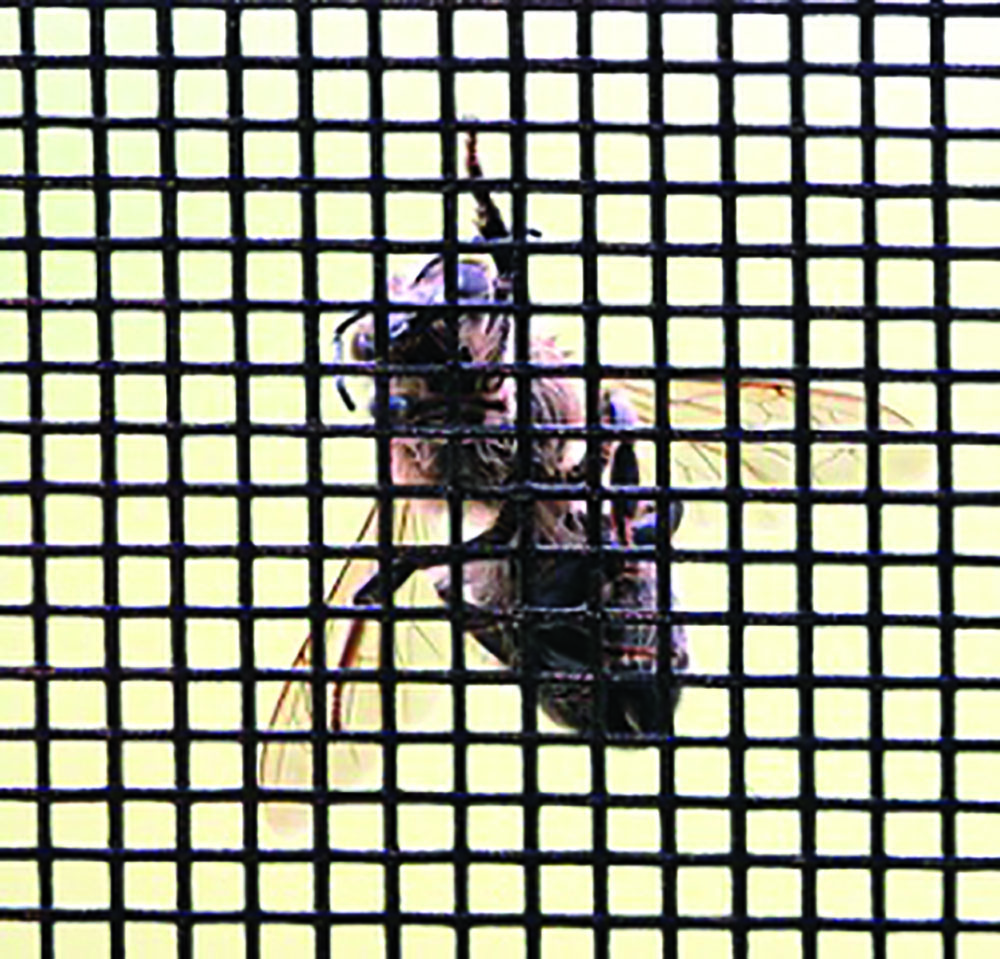
In death, a lonely bee that made herself known to me.
Just before this past Christmas – for me now, about three weeks ago – I noticed that a bee was hanging on my bedroom window screen. I didn’t give her much thought. A few days later, the bee was still there. By now there was no doubt that she was dead. It was an interesting event, but not that interesting. Now after all these weeks, the bee is still hanging there and still hanging by a front single leg. Each morning I generally check the sunrise. Now, checking the bee, suspended by her unyielding single leg, is a second morning ritual for me.
If this bee wanted to be a special memory that stands out from all the great number of bees I have been around, she has certainly scored. I won’t forget this one. I admit, that when her bee body finally falls to the ground, I will miss her a bit. From the masses of bees, she made herself known. How long can that leg hold out?
Dr. James E. Tew, State Specialist, Beekeeping, The Alabama Cooperative Extension System, Auburn University; Emeritus Faculty, The Ohio State University. Tewbee2@gmail.com; http://www.onetew.com; One Tew Bee RSS Feed (www.onetew.com/feed/); http://www.facebook.com/tewbee2; @onetewbee Youtube: https://www.youtube.com/user/onetewbee/videos







